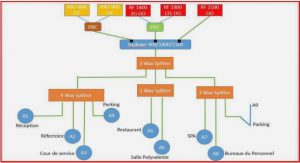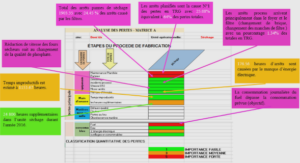Development of the algorithms and preliminary validation
Legislation and recommendations regarding risk of hearing loss
Recommendations and legislation regarding occupational noise exposure have been issued around the world. Although different in their details, the different recommendations and legislation aim at limiting the cumulative sound exposure level that workers are subject to, during a full day of work, to be inferior to a hazardous sound exposure threshold, usually weighted in dB(A). On one hand, organisms such as the World Health Organization (WHO) or the National Institute for Occupational Safety and Health (NIOSH) define recommended exposure limits (REL) based on scientific studies relating hearing loss to the level and duration of noise exposures, according to Niquette (2012). The recommendations of WHO and NIOSH are different because their goal is different. WHO aims at defining recommendations that would protect all workers, while NIOSH aims at defining recommendations that would protect the majority of workers. Since some humans are more at risk than others because of genetic predisposition as well as other factors, following NIOSH’s recommendation does not guarantee that one will not develop NIHL. On the other hand, organisms such as the Occupational Safety and Health Organization (OSHA) enforce a legislation and define a permissible exposure limit (PEL) resulting from « debates and compromises that are part of enacting any legislation », according to Niquette (2012). Therefore, some legislations may not adequately protect a significant portion of worker.
Efficiency of commercially available hearing protection devices
Although specialized HPDs have benefited several musicians, many studies show that professional classical musicians generally do not use hearing protection devices. In France, out of 190 professional classical musicians surveyed by Richoux et al. (1998), none used hearing protection devices while 47% reported suffering from symptoms associated to sound overexposure. Similar populations were surveyed in other European countries, and the use of HPDs was found to be 6% in Finland, 15% in Denmark and about 10% in Germany, as reported by Huttunen et al. (2013).
The highest usage rate of the studied populations was in the Netherlands, with 52% of the musicians reporting using HPDs in rehearsal, but only 29% using them in concerts. HPDs seem to be generally more accepted in amplified music, although musicians still find problems with them. Santoni and Fiorini (2010) studied the acceptance of pre-molded musicians earplugs in a Brazilian population of contemporary musicians that were trained with their use, and asked to try them for a period of 3 months. Although general satisfaction towards the earplug was reported by 73.4% of the population, 43.5% reported they disagreed, or strongly disagreed, with using earplugs when performing in shows. Only 4.3% of musicians reported having no negative sensation from wearing the HPD, and « dampened voice » was the most reported negative sensation, with an occurrence of 43%.
The electro-acoustic path
In this section, the electro-acoustic path is modeled with IIR and FIR filters, element by element, either through design of filters or by using the same system identification procedure used in chapter 3 and described in appendix II. The motivation for modeling each element of the paths rather than the just the entire paths or the complete system is to be able to predict how changing a single or many elements will affect the overall performance of the isolation effect compensation system. This is useful to predict how the isolation effect compensation system could behave when used by itself, or in conjunction with the active occlusion effect reduction system, and to identify the elements that could be changed to improve the performance of the isolation effect compensation system.
Validation of the electro-acoustic path model
Cascading all the separate models of the elements and accounting for the transducers’ sensitivity should result in the complete electro-acoustic path model. Measuring its complete transfer function from the sound right before it is picked up by the external microphone to the ATF « eardrum » microphone is difficult because it would require that a reference microphone be positioned exactly where the external microphone is. Since this is physically impossible, the reference microphone is at a distance from the external microphone and this difference in position causes a phase shift, resulting in a difference in phase between the model and the measured transfer function.
Additionally, the physical placement of the reference microphone close to the HPD causes the reference microphone to pick up sound reflected by the HPD and the ATF, and therefore amplitude differences between the model and the measured transfer function are observed. Figure 4.9 compares the prediction of the model when a high gain of 20 dB is programmed in the DSP, so that the attenuation path is negligible, with the measured transfer function of the real system using a reference microphone that is placed as close as possible to the outside of the HPD. The case considered here uses the uncompensated plant playback option, without the effect of the active occlusion effect reduction system.
|
Table des matières
INTRODUCTION
CHAPTER 1 LITERATURE REVIEW
1.1 Context of the problem
1.1.1 Music-induced hearing loss
1.1.2 Legislation and recommendations regarding risk of hearing loss
1.1.3 Efficiency of commercially available hearing protection devices
1.2 The occlusion effect
1.2.1 Characteristics of the occlusion effect
1.2.2 Measuring the occlusion effect
1.2.3 Solutions to the occlusion effect
1.3 Active noise control
1.3.1 Feedback active noise control
1.3.2 Analog implementation of compensators
1.3.3 Digital implementation of compensators
1.4 Active noise reduction in the ear canal
1.4.1 The effect of ear canal variability on the plant response
1.4.2 Transducers technologies in regard to active noise control
1.4.2.1 Moving-coil loudspeakers
1.4.2.2 Balanced armatures loudspeakers
1.4.2.3 Electrostatic loudspeakers
1.4.2.4 Piezoelectric loudspeakers
1.4.2.5 Electret condenser microphones
1.4.2.6 MEMS microphones
1.5 The isolation effect
1.5.1 The open and occluded ear responses
1.5.2 Attenuation and acceptance of commercially available hearing protection devices
1.5.2.1 Commercially available earplugs for musicians
1.5.2.2 Acceptance of commercially available earplugs for musicians
1.5.3 Loudness and its impact on the perceived attenuation
1.5.3.1 Loudness of pure tones
1.5.3.2 Loudness of complex sounds
1.5.3.3 The impact of loudness and sound pressure level on music perception
1.6 Summary of the literature review
1.6.1 Regarding the occlusion effect
1.6.2 Regarding the isolation effect
CHAPTER 2 DEFINITION OF THE REQUIREMENTS OF THE SYSTEM
2.1 Design Background
2.1.1 The SonoFit technology
2.1.2 The Auditory Research Platform
2.2 Requirements of the solution to occlusion effect
2.2.1 Performance requirements
2.2.2 Controller requirements
2.2.3 Plant’s requirements
2.2.3.1 Physical interfaces to the ear
2.2.3.2 The internal loudspeaker and microphone components
2.2.3.3 Gain and phase margins requirements
2.3 Requirements of the solution to isolation effect
2.3.1 Uniform attenuation
2.3.2 Variable attenuation
2.3.3 Requirements of the loudness compensation solution
CHAPTER 3 A SOLUTION TO THE OCCLUSION EFFECT
3.1 Proposed architecture and design
3.1.1 Moldable-fit earpiece
3.1.2 Universal-fit earpiece
3.1.3 Design of the controller
3.2 Implementation and experimental validation
3.2.1 Implementation
3.2.2 Experimental validation using the moldable-fit earpiece
3.2.3 Experimental validation using the universal-fit earpiece
3.3 Discussion regarding the solution to occlusion effect
CHAPTER 4 A SOLUTION TO THE ISOLATION EFFECT
4.1 Proposed architecture and modelling of components
4.1.1 The electro-acoustic path
4.1.1.1 External microphone
4.1.1.2 Digital signal processor
4.1.1.3 Playback
4.1.1.4 Occluded ear canal
4.1.1.5 Validation of the electro-acoustic path model
4.1.2 The attenuation path
4.1.2.1 Passive attenuation
4.1.2.2 Active attenuation
4.2 Development of the algorithms and preliminary validation
4.2.1 Uniform magnitude transfer function compensation
4.2.2 Open ear correction
4.2.3 Variable gain and combination correction
4.2.4 Preliminary experimental validation
4.2.5 Loudness compensation
4.3 Isolation effect compensation system in conjunction with the active occlusion effect reduction system
4.4 Discussion regarding the solution to isolation effect
CONCLUSIONS
APPENDIX I VARIABILITY OF PLANT RESPONSE BETWEEN INSERTIONS
APPENDIX II SYSTEM IDENTIFICATION PROCEDURE
APPENDIX III CONTROLLER CIRCUITS
APPENDIX IV LOUDNESS COMPENSATION SCRIPT
APPENDIX V PICTURES
APPENDIX VI PUBLICATIONS
REFERENCES
BIBLIOGRAPHY
![]() Télécharger le rapport complet
Télécharger le rapport complet






